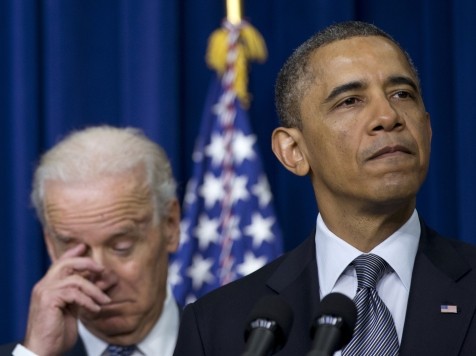
Today the White House launched its four point plan to “protect our children and our communities by reducing gun violence.” The brochure capitalizes on the Sandy Hook tragedy to push a scatter-shot package of progressive measures which the White House insists are merely “common sense.”
The first page offers an executive summary of what follows along with references to Sandy Hook, Newtown, Aurora, Oak Creek and Tucson. It closes by once again focusing on children, “If even one child’s life can be saved, then we need to act.”
The rest of the document is broken into four major points with many sub-sections. Point one is closing background check loopholes and it opens with another reference to Sandy Hook:
We must strengthen our efforts to keep guns from falling into the wrong hands…The single most important thing we can do to prevent gun violence and mass shootings, like the one in Newtown, is to make sure those who would commit acts of violence cannot get access to guns.
The guns used in the Newtown shooting were bought legally by the shooter’s mother. He stole her guns, shot her while she slept and made his way to the school. There is literally nothing in this section that, if enacted, would have changed the outcome. Sub-points include expanding background checks and insuring all states are contributing to the national database of people with mental illness. These might be worthy changes but again suggesting it would have stopped what happened in Newtown is pure emotional manipulation.
Step two is to ban “military-style assault weapons” and high-capacity magazines. This is essentially an effort to reinstate the ban which existed from 1994-2004. But this section also includes four other sub-sections covering everything from additional law enforcement “tools” to spending federal money on gun violence research.
One of the priorities in this section is a “national responsible gun ownership campaign.” The document isn’t specific but this would likely be modeled on other government campaigns such as the one against smoking or drug use (“This is your brain on guns”). In practice this could be safety tips about gun storage or it could becomes a media slush-fund to stigmatize gun owners as heartless monster, like the people who let their second hand smoke waft toward babies.
The big budget item in this section is a plan to spend $4 billion keeping 15,000 cops “on the streets.” But again it’s not clear how this priority connects to any of the mass shooting incidents the document is ostensibly aimed at preventing. How will 15,000 more cops prevent the next school shooting if they are not on campus when the shooting begins?
In section three we finally get to “Making Schools Safer” which really ought to be the focus. Obama is proposing funding for 1,000 school resource officers at a cost of $150 million. This is a fraction of what he proposes to spend on cops in general ($4B) and seems insignificant in a country with more than 70,000 public schools. Chances that your elementary school will get an armed officer as a result of this program are exceedingly slim.
The other parts of this section include insuring schools have an emergency management plan and creating a “safer climate” at schools. The former seems like a good idea but the latter is rather vague. It involves spending $50 million to have the Department of Education train 8,000 schools to “improve climate.” There is a mention of “more intensive steps for groups of students exhibiting at-risk behavior” but it’s not clear from the document what this means or which groups are at risk.
Section four is titled “Improving Mental Health Services.” Here the documents suggests but never quite says outright that mental issues were involved in the shootings at “Newtown, Tucson, Aurora, and Virginia Tech.” The proposal involves training teachers to identify troubled kids and then insure they get treatment. It also lays out a proposal to train 5,000 mental health professionals to work with kids and young adults.
The mental health approach does seem like common sense though it’s not clear the items proposed would have prevented the shootings mentioned prominently in the document. Adam Lanza, Jared Loughner and Seung-Hui Cho were all known to have social/mental problems by their parents and teachers. They had been identified (James Holmes’ problems seem to have cropped up later) but obviously didn’t get sufficient help. Is that because help wasn’t available or because their parents wanted to avoid the stigma?
The President’s gun proposal throws a lot of progressive spaghetti at the wall (to mix metaphors) in the hope that some of it will stick. Some of it will and perhaps some of it really should, but the items which seem most likely to prevent another Sandy Hook–cops in schools, mental health intervention–receive less money and attention than the ones designed primarily to please Obama’s progressive constituency. It’s an odd mix until you realize this is as much a political document as it is a practical one.

COMMENTS
Please let us know if you're having issues with commenting.